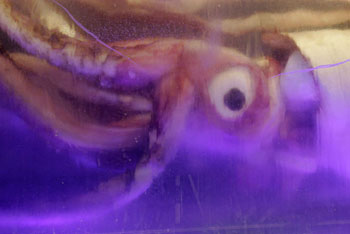Please note: Osher Rainforest will be closed for maintenance Jan. 14–16.
Science News
Eyeball Mystery
March 20, 2012

Since we are approaching the Sweet Sixteen, we thought we’d give you not a basketball story, but a basketball eyeball story: Eyes as big as basketballs that are a bit of a mystery. The story starts at Duke University (who didn’t even make it past the first round, btw).
First of all, let’s start with the owners of these gigantic, 10-inch-plus diameter eyeballs—big squids. Big squids come in two types—giant and colossal. They can grow to weights of five adult men put together, which is comparable to a large swordfish. But swordfish eyes are about the size of softballs, about 3 inches in diameter.
Duke’s Sonke Johnsen found this size confounding. “It doesn't make sense that a giant squid and swordfish are similar in size but the squid's eyes are proportionally much larger, three times the diameter and 27 times the volume. The question is why. Why do giant squid need such large eyes?”
Big squid live way down deep in the ocean—up to depths of over 3,000 feet. It’s pretty dark down there, and large eyes can capture more light, but researchers found that it doesn’t really pay to have eyeballs larger than an orange at that depth. As lead author of a paper on the discovery, Dan-Eric Nilsson of Lund University, remarked, “Making eyes larger than that will only marginally improve vision, but eyes are expensive to build and maintain.”
So the researchers built computer models to understand why these giant and colossal squids evolved to have such large peepers. They discovered that the extra light intake improves the squid’s ability to detect small contrast differences under the dim conditions of the deep ocean.
The team then realized that one of these squids’ predators, sperm whales, dive and swim continuously while emitting sonar to ping the squid. The cephalopods are deaf to the sonar, but the whales’ wake triggers small organisms like plankton to produce light (bioluminescence). Based on the design of the squid's eye, the animal could see this light, though contrast is low, over "freakishly long distances," about the length of an American football field, and escape the whales, Johnson said.
"It's the predation by large, toothed whales that has driven the evolution of gigantism in the eyes of these squid," Johnsen said.
The new model will be used to predict how far other animals can see underwater. "It is a powerful tool for understanding vision," according to Nilsson.
Image: Fir0002/Wikipedia